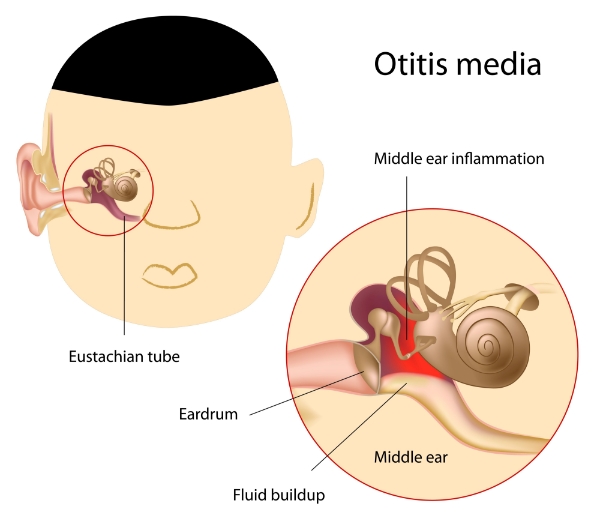Chronic Ear Infections

Chronic ear infections refer to both an ear infection that does not heal or to recurring ear infections. A chronic ear infection affects the middle ear (otitis media) and develops when fluid or an infection behind the eardrum does not go away.
Otitis Media refers to inflammation of the middle ear. When an abrupt infection occurs, the condition is called “acute otitis media.” This condition occurs when a cold, allergy, virus, or the presence of bacteria leads to the accumulation of pus and mucus behind the eardrum, thus blocking the Eustachian tube. This can cause earache and fever.
When fluid sits in the middle ear for weeks, the condition is known as “otitis media with effusion.” This condition occurs in a recovering ear infection. Fluid can remain in the ear for weeks to many months. If not treated, chronic ear infections have potentially serious consequences, such as temporary hearing loss.

Children Have More Ear Infections Than Adults
To understand earaches and ear infections, you must first know about the Eustachian tube. The Eustachian tube is a narrow channel connecting the inside of the ear to the back of the throat, just above the soft palate and uvula. The tube allows drainage of fluid from the middle ear, preventing fluid from building up and bursting the thin eardrum. In a healthy ear, the fluid drains down the tube, assisted by tiny hair cells, and is swallowed.
The tube also maintains middle ear pressure equal to the air outside of the ear, enabling free eardrum movement. Most of the time, the tube is collapsed in order to prevent germs residing in the nose and mouth from entering the middle ear. Infection occurs when the Eustachian tube fails to do its job. When the tube becomes partially blocked, fluid accumulates in the middle ear, trapping already present bacteria which then multiply.
Children have Eustachian tubes that are shorter, more horizontal, and straighter than those of adults. These factors make the journey for the bacteria quick and relatively easy. They also make it harder for the ears to clear the fluid since it cannot drain with the help of gravity. A child’s tube is also floppier, with a smaller opening that easily clogs.
Otitis Media Affects Hearing
Most people with a middle ear infection (otitis media) or fluid have some degree of hearing loss. The average hearing loss in ears with fluid is 24 decibels, equivalent to wearing ear plugs (twenty-four decibels is about the level of the very softest of whispers). Thicker fluid can cause a more severe loss of up to 45 decibels (the range of conversational speech).
You should suspect hearing loss if one is unable to understand certain words and speaks louder than normal.
Types of Hearing Loss
Conductive hearing loss is a form of hearing impairment where the transmission of sound from the environment to the inner ear is impaired, usually from an abnormality of the external auditory canal or middle ear. This form of hearing loss can be temporary or permanent. Untreated chronic ear infections can lead to conductive hearing loss. If fluid is filling the middle ear, hearing loss can be treated by draining the middle ear and inserting a tympanostomy tube.
Sensorineural hearing loss is the other form of loss. This type of hearing loss is due to abnormalities of the inner ear or the auditory division of the 8th cranial nerve. Historically, this condition can occur at all ages and is usually permanent.
Reasons for Hearing Loss
Children and adults can incur temporary hearing loss for other reasons than chronic middle ear infection and Eustachian tube dysfunction. Reasons for hearing loss include:
- Ear wax impaction
- Otitis externa: Inflammation of the external auditory canal, also called “swimmer’s ear.”
- Cholesteatoma: A mass of horn-shaped squamous cell epithelium and cholesterol in the middle ear usually resulting from chronic otitis media.
- Otosclerosis: This is a disease of the otic capsule (bony labyrinth) in the ear. The condition is prevalent primarily in adults and characterized by the formation of soft vascular bone leading to progressive conductive hearing loss. It occurs due to fixation of the stapes (bones in the ear). Sensorineural hearing loss may result because of involvement of the cochlear duct.
Chronic Ear Infections - FAQs
With an ear infection, the Eustachian tube, a tube that normally drains fluid from the middle ear, becomes plugged and infected. This buildup of fluid presses on the eardrum, causing pain. Eustachian tubes in children are smaller and more horizontal, so they can become plugged more easily. This is why ear infections occur more commonly in children.
The Eustachian tube is the canal that links the middle ear with the throat. This tube allows air into the middle ear and drainage of fluid.
The Eustachian tube may not work properly due to
- Viral illness
- Exposure to allergens or tobacco smoke (leads to swelling of the Eustachian tube resulting in fluid build-up in the middle ear)
- Poor Eustachian tube function (often the result for children with a cleft palate and craniofacial syndromes like Down’s Syndrome)
A chronic ear infection can cause milder symptoms than an acute ear infection.
Symptoms may affect one or both ears and may be constant or come and go. Signs include:
- A feeling of pressure in the ear
- Mild ear pain
- Fluid draining from ears
- Low fever
- Hearing loss
- Trouble sleeping
A hearing test should be performed for children who have frequent ear infections, have hearing loss that lasts more than 6 weeks, or have fluid in the middle ear for more than 3 months. There are a wide range of medical devices now available to test a child’s hearing, Eustachian tube function, and flexibility of the eardrum. These devices include the otoscope, tympanometer, and audiometer.
Treatment options for recurring ear infections may either be surgery or antibiotic treatment. We follow established guidelines to determine which patients should be considered for surgery, and which patients can continue to receive antibiotics for their infections.
A myringotomy is a procedure in which your doctor creates a small hole in the eardrum so fluids such as water, blood, or pus can drain out. In many cases, your doctor will put in tympanostomy tubes, known as ear tubes or PE tubes, so the eardrum won’t get backed up again. Before surgery, the doctor will conduct a thorough examination and order a hearing test to determine if your child has a hearing loss. After surgery, your child will undergo another hearing test to determine if his or her hearing has improved. Follow-up care is also provided to manage children for the length of time they have ear tubes to make sure they remain free of ear infections and complications.
In placing the tubes in your child’s ear(s), they
- Allow air to re-enter middle ear space
- Reduce the number and severity of infections
- Improve hearing loss caused by middle ear fluid
Tubes usually fall out of the ear in 6 months to 2 years. If they remain in longer than 2 to 3 years, they are sometimes removed.
If chronic ear infections are left untreated, it may result in hearing loss. If hearing loss affects both ears, the damage to the middle ear may slow language and speech development. While permanent hearing loss is rare, the risk increases with the number and length of infections.
Besides hearing loss, other complications such as a ruptured eardrum may occur if chronic ear infections are left untreated.
There are several things you can do to prevent your child from getting chronic ear infections including
- Vaccinate your child against the flu.
- Keep your child away from sick children.
- Wash your hands frequently to prevent the spread of germs.
- Avoid exposing your baby to cigarette smoke.
- Seek prompt treatment for an acute ear infection.
- Request follow-up exams with your provider after an ear infection has been treated to make sure that the infection is completely cured.
Contact Us
If your child is having symptoms of an acute ear infection (e.g., ear pain, fever, and trouble hearing) or has had issues with chronic ear infections, call Integrated ENT at (303) 706-1616 to schedule an appointment for evaluation and treatment.







